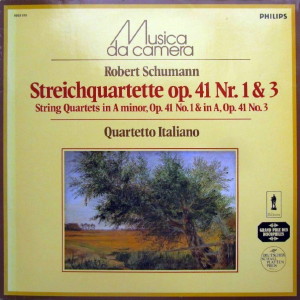 |
|
Philips
- 1 LP - 6503 070
|
|
QUARTETTO ITALIANO
- Paolo Borciani, Elisa Pegreffi, violino
- Piero Farulli,
viola
- Franco Rossi, violoncello |
|
|
|
|
|
Luogo e data
di registrazione |
|
Théâtre
Vevey, Vevey (Svizzera):
-
18-31 agosto 1967
(Op. 41
No. 1)
-
13-24 luglio
1970 (Op. 41 No.
3)
|
|
|
Registrazione: live
/ studio |
|
studio |
|
|
Producer / Engineer |
|
Vittorio Negri |
Tony Buczynski |
|
|
Edizione LP |
|
Philips | 6503
070
| 1 LP |
|
|
Prima Edizione CD |
|
Vedi link alla prima
edizione in long playing.
|
|
|
Note |
|
La
collana
"Musica da
Camera" della
Philips
riedita negli
anni
'80
alcune
registrazioni
del Quartetto
Italiano. |
|
|
|
|
Most
of Schumann's
work can be
classified in
periods which
coincide with
successive
preoccupations.
First and
probably
foremost he
was a composer
of piano
music. Then in
1840 came the
great flood of
songs. The
following year
1841 was the
year of
orchestral
works. Chamber
music followed
in 1842; after
preliminary
sketches, the
first of his
three string
quartets was
begun on June
4 and before
it was
completed, he
began the
second on June
11. The third
was begun on
July 8 and
completed on
July 22.
If
any doubt
remained in
some people's
minds about
Schumann's
true genius
as a composer,
the quartets
helped to
settle the
matter. In
them, he
obviously
found an
outlet for the
"new" sounds
he was hearing
and about
which he had
written to
Clara in
1838: "It is
remarkable how
almost all my
ideas now are
canonic and
how I always
discover the
imitating
voices later,
often in
inversion or
in changed
rhythms..."
The
flanking
movements in
the first
Quartet, in A
minor, are in
sonata form
and are
astonishingly
concise
in their
expositions:
the brief,
unassuming
second
subjects seem
to evolve
naturally from
the main
themes. In the
finale, for
instance, the
second subject
begins with an
inversion of
the first
subject's
opening notes.
Another
unusual
feature of
this finale is
the use of
what might be
described as a
"marker"
passage - a
musette-like
drone on the
cello with,
above it, a
rising
diminished
seventh on the
viola which
signals the
start of the
irregular
recapitulation.
In the coda we
find a more
extended
musette
passage in A
major.
The
song-like Adagio
of this
quartets is
preceded by a
puckish
scherzo whose
theme was from
a trio by
Heinrich
Marschner;
Schumann later
used it as an
accompaniment
to one of his
songs.
In
the third
quartet, in A
major,Schumann
allows himself
more scope for
the kind of
romantic
expression one
expects of
him. The
sighing
falling fifth
of the
introduction
dominates the
first movement
and its
inversion, a
rising fourth,
is the vital
force in the
scherzo, which
consists of
four
variations on
a restless
theme in F
sharp minor.
The third of
these is a
rocking Adagio
so melodious
that some
commentators
have suggested
it is the
actual theme
making its
first
appearance. A
powerful
waltz, almost
orchestral in
texture,
follows before
a coda, full
of melodic and
harmonic
surprises,
carries the
movement to a
major close.
The
boisterous
finale plays
Florestan to
the
Eusebius
of the
long
expressive Adagio
in D, worked
out on a loose
sonata-form
pattern. The
coda of the
Adagioa
lends its
dotted rhythm
to the
finale`s rondo
theme which
alternates
with two
episodes
before a
gavotte-like
“quasi” trio
in F. Main
theme,
episodes, and
“trio” theme
are then
recalled
before a long
coda which
amounts to a
terminal
development of
the rondo
subject.
A.
David Hogarth
|
| Illustration:
Johann Jacob Gensler (1808-1845)
"Alter Weidenbaum", 1842
(Kunsthalle, Hamburg)
|
|